United Kingdom
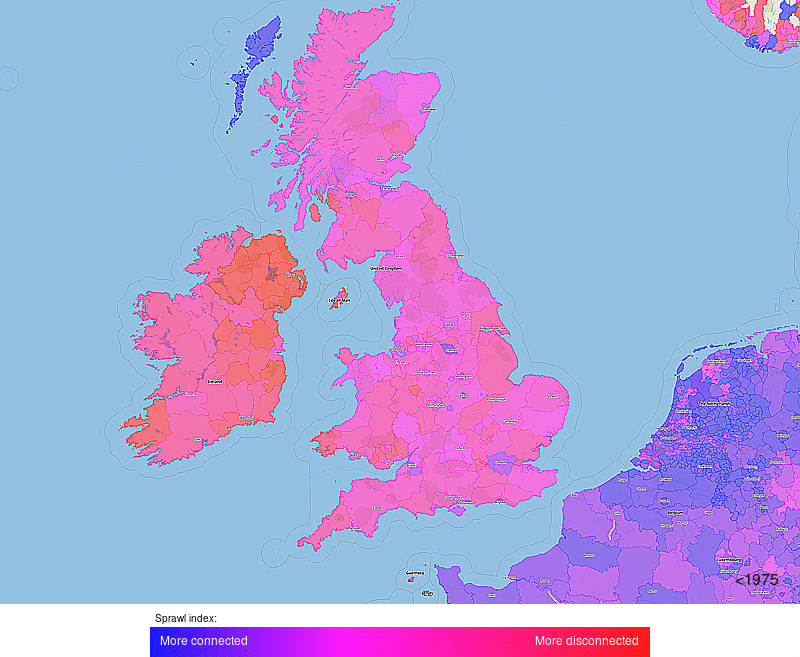
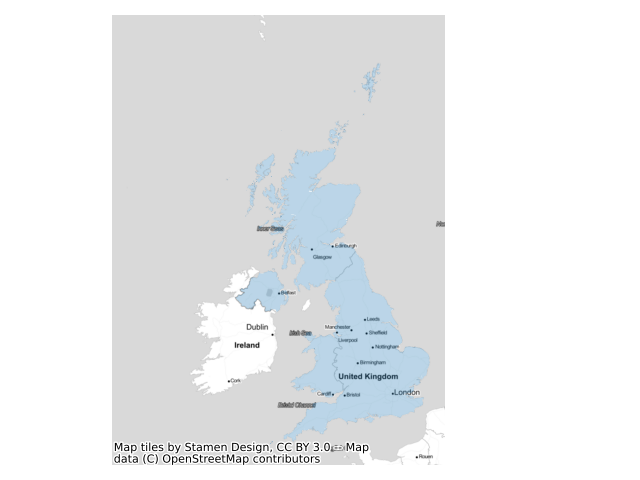
What exactly constitutes the spatial extent of the city? For these aggregations, we used the Global Human Settlement Layer Urban Center Database (GHS-UCDB) to define the boundaries of the city. These cities -- or urban centers -- cover areas that are densely populated and built-up, and so may extend beyond the spatial borders of these cities that we may be familiar with. The GHS area is shaded in blue.
View United Kingdom on the sprawlmap
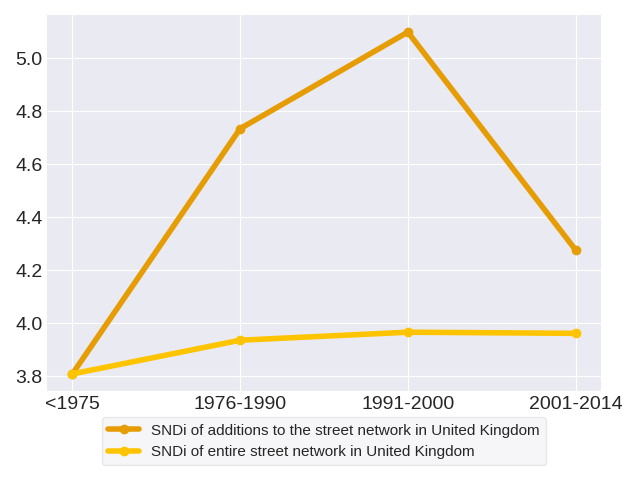
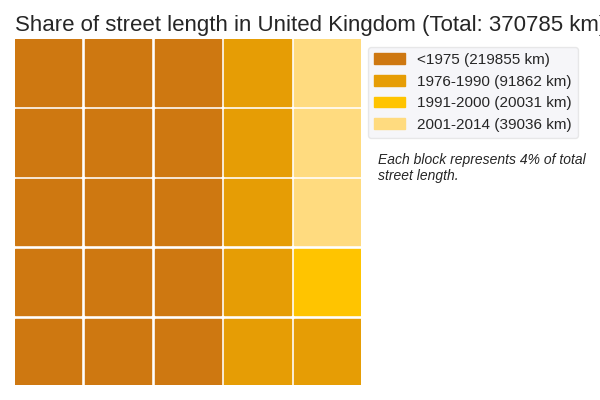
Most recent snapshot: Taking into account the entire (i.e. aggregate) street network in United Kingdom as of 2014, the overall level of street-network sprawl is 3.96, which is highly disconnected.
Trends in street network construction: The SNDis of street construction for the respective time periods are 3.81, 4.73, 5.1 and 4.28. Street construction in United Kingdom increased in disconnectivity initially but has since improved. The streets constructed in 1991-2000 were the most disconnected.
Quantity of street network construction: The street network in United Kingdom spans a total of 370785 kilometers. It is dominated by roads constructed prior to 1975. These roads have an SNDi of 3.81, which is highly disconnected.
Effect on the aggregate network: New construction in each period adds to the total stock of streets, but does not change streets that have already been built. Therefore, it has a limited effect on the street network as a whole. The SNDis of the aggregate street network in the respective time periods are 3.81, 3.94, 3.97 and 3.96. The aggregate street network in United Kingdom increased in disconnectivity initially,but the trend has turned around after 2000.
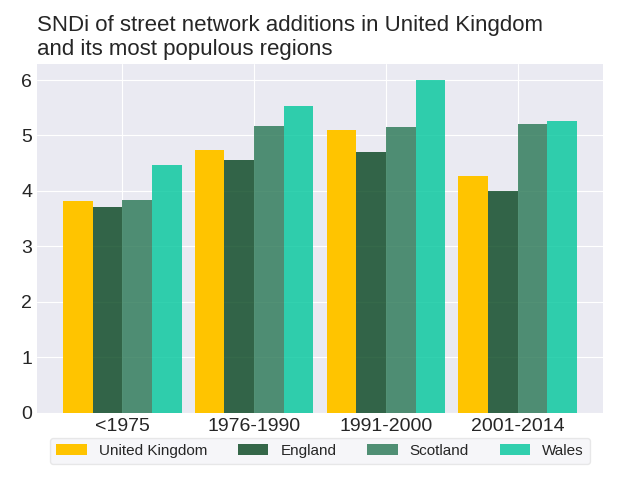
The level of street-network sprawl in new development in United Kingdom peaked in 1991-2000. To get a sense of how street development has changed in United Kingdom, we can consider three of its most populous regions: England, Scotland and Wales. Out of the three regions, Scotland does not follow the same trend as the country. The level of street-network sprawl in new development in Scotland followed a zig-zag trend with an overall increase.
How do development practices in United Kingdom fare in comparison to others in the world? Most recently in 2001-2014, street construction in United Kingdom was the 80th-most disconnected out of the 155 countries in the world. Its position in the ranks since 1975 has fallen; relative to other countries in the world, street construction in United Kingdom has become more connected. United Kingdom ranked 43rd in 1975, 32nd in 1976-1990, 49th in 1991-2000 and 80th in 2001-2014.
The largest city in United Kingdom is London, with a population of 9609600 people. Taking into account the entire (i.e. aggregate) street network in London as of 2014, the overall level of street-network sprawl is 3.03, which is in the 40th to 60th percentile of disconnectedness. The level of street-network sprawl in new development in London peaked in 1991-2000.
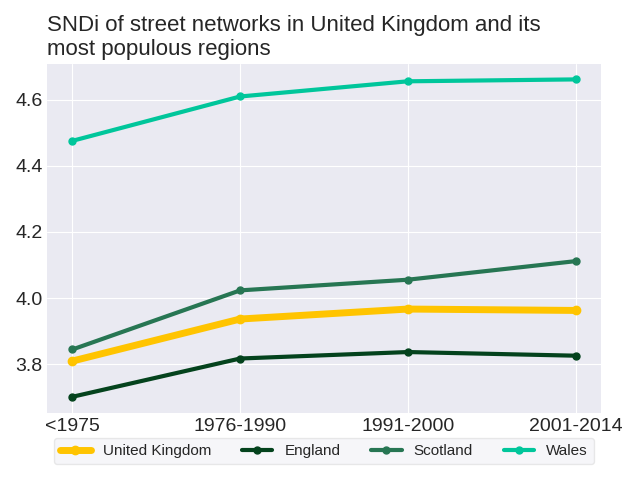
As of 2014, the city with the most disconnected street network in United Kingdom is Londonderry/Derry with an SNDi of 7.72, which is highly disconnected. Conversely, the most connected city is Great Yarmouth with an SNDi of 2.35, which is in the 40th to 60th percentile of disconnectedness. See trends for these cities: Great Yarmouth, Londonderry/Derry
The level of street-network sprawl in the aggregate network in United Kingdom peaked in 1991-2000. To get a sense of how the aggregate street network has changed in United Kingdom, we can consider three of its most populous regions: England, Scotland and Wales. Out of the three regions, Scotland and Wales do not follow the same trend as the country. The level of street-network sprawl in the aggregate network in Scotland rose steadily. The level of street-network sprawl in the aggregate network in Wales rose steadily.
To date, United Kingdom is the 53rd-most disconnected out of the 155 countries in the world. Its position in the ranks since 1975 has fallen; relative to other countries in the world, the street network in United Kingdom has become more connected. United Kingdom ranked 43rd in 1975, 47th in 1976-1990, 50th in 1991-2000 and 53rd in 2001-2014.
The largest city in United Kingdom is London, with a population of 9609600 people. Taking into account the entire (i.e. aggregate) street network in London as of 2014, the overall level of street-network sprawl is 3.03, which is in the 40th to 60th percentile of disconnectedness. The level of street-network sprawl in the aggregate network in London rose steadily.